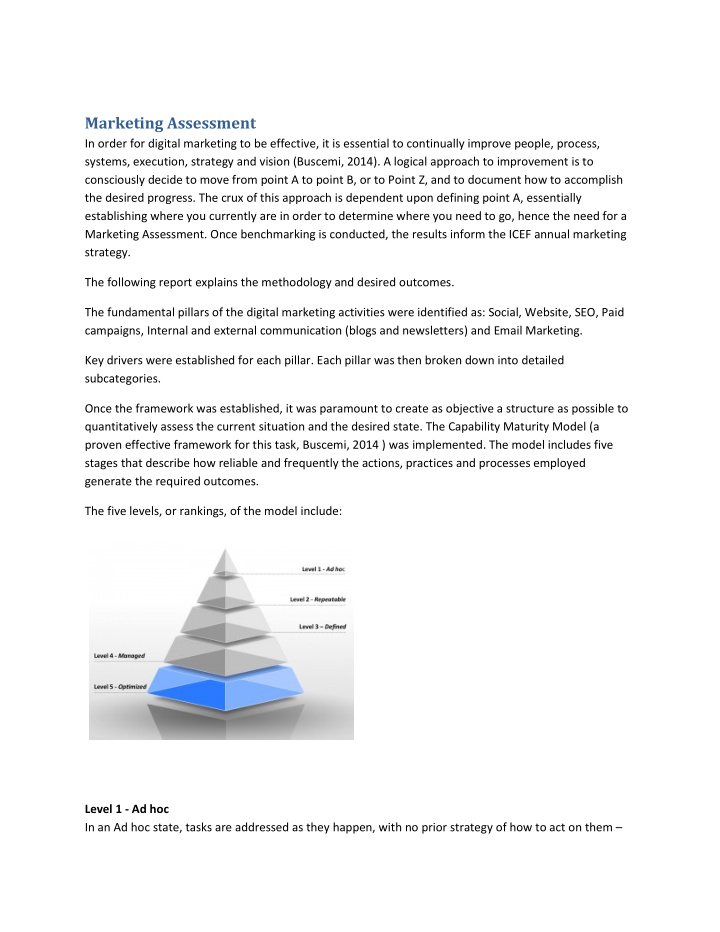



Marketing Assessment In order for digital marketing to be effective, it is essential to continually improve people, process, systems, execution, strategy and vision (Buscemi, 2014). A logical approach to improvement is to consciously decide to move from point A to point B, or to Point Z, and to document how to accomplish the desired progress. The crux of this approach is dependent upon defining point A, essentially establishing where you currently are in order to determine where you need to go, hence the need for a Marketing Assessment. Once benchmarking is conducted, the results inform the ICEF annual marketing strategy. The following report explains the methodology and desired outcomes. The fundamental pillars of the digital marketing activities were identified as: Social, Website, SEO, Paid campaigns, Internal and external communication (blogs and newsletters) and Email Marketing. Key drivers were established for each pillar. Each pillar was then broken down into detailed subcategories. Once the framework was established, it was paramount to create as objective a structure as possible to quantitatively assess the current situation and the desired state. The Capability Maturity Model (a proven effective framework for this task, Buscemi, 2014 ) was implemented. The model includes five stages that describe how reliable and frequently the actions, practices and processes employed generate the required outcomes. The five levels, or rankings, of the model include: Level 1 - Ad hoc In an Ad hoc state, tasks are addressed as they happen, with no prior strategy of how to act on them –
this is a reactionary process. In most cases, there is no documentation available that might help complete the task. There is also no knowledge base built from previously completing such tasks. Level 2 - Repeatable Here, the organization can use the knowledge gained from previously performing a similar task to complete the new one, although this may not be consistent across all tasks. Level 3 – Defined A defined state means that there is a defined, documented process used for specific tasks. This is not used to improve the process, but rather to ensure that consistency is in place. Level 4 - Managed In a managed state, there is a definite process in place, as well as metrics that can track, monitor and manage each one. Level 5 – Optimized The optimized state is somewhat similar to the managed state, with the major difference being that the focus shifts to improving the process through training, enhancements, improvements and automation. Optimized is often considered to be the most effective as processes are being systematically managed and constantly improved. Each of the pillars need to be evaluated against six specific criteria and scored on the 5 point rating scale: - Current State: how the organization is ranked as of today - Desired State: the ranking that the organization would like to achieve - Gap: the perceived difference between Current and Desired states - Dependencies: what the organization needs to do at the top level to move from Current to Desired State - Investment: the resources that need to be added to close the Gap All of the above provides the foundation for the Marketing Assessment spider diagram. Members of the team will meet and collectively rank each category and sub-category of marketing activities. Current state, desired state and the gap will be identified. (See document Marketing Assessment Framework – worksheet) It is important to note that the desired state of all pillars and sub-categories is not necessarily Step 5- Optimized. Depending on the task, the desired state may be a Step 2- repeatable or a Step 3 – Defined, for instance. A crucial component of this exercise is to determine (as a team) the desired state of a task. In order to determine the desired state, the key business objectives (KBO’s) of the department are examined along with the established goals of the department for the year.
Marketing Assessment Spider Diagram The final piece in this marketing assessment is the Spider Diagram. The diagram shows an example of the performance of all attributes in a clear, integrated manner. A Spider Diagram of each of the key pillars will be created. A diagram for each pillar and sub-categories was also be created to provide clear insight into every pillar of marketing activities. All activities will then be seen in a single place. This will allow for substantiated decision making regarding digital investment strategy and the allocation of tasks and priorities. All Digital Marketing Website 5 Paid Digital 4 SEO Advertising 3 2 1 Desired State Int/ext SEM 0 communications Current State Social Media Email Marketing Video Marketing 5- Optimized 0-No activity 1- Ad hoc 2-Repeatable 3-Defined 4-Managed Digital Marketing Summary: The desired state for all digital marketing moving forward for FY2017 was established at a 5 – Optimized. As you can see from the above diagram, the areas that needs the most attention are the Website, SEO, SEM and Video Marketing. These pillars are currently ranked as a 2- Repeatable, with the exception of paid SEM which is ranked at 1 – Ad hoc because we have done so little of this up until no w. The desired state is a 5-Optimized. The gap between the current state and the desired state is a 3 indicating these areas are a significant priority. Some efforts have been attempted in each of these areas but the process has not been defined. There is an immediate need to shift resources to support these areas.
Recommend
More recommend